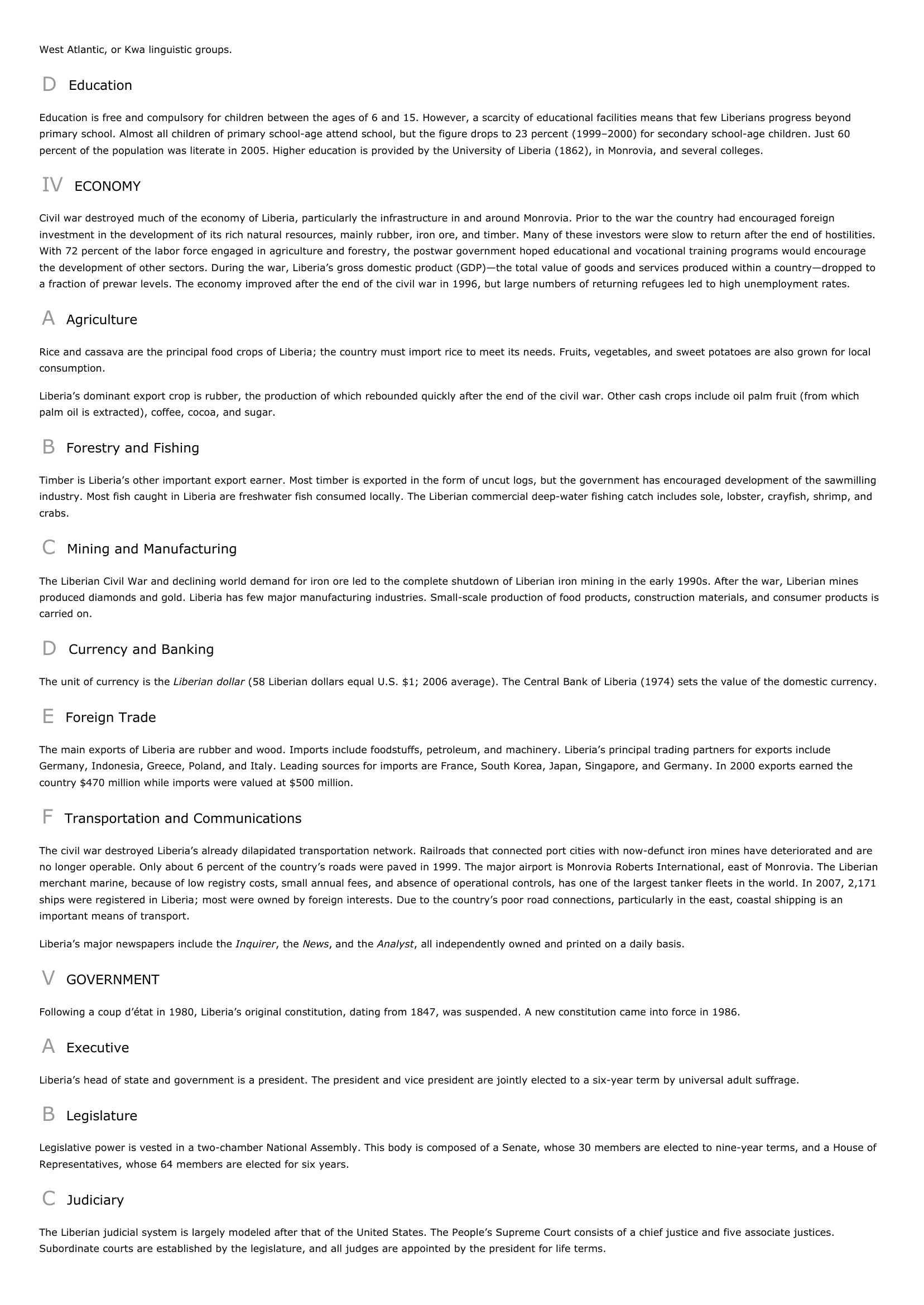Liberia - country.
Publié le 04/05/2013

Extrait du document
«
West Atlantic, or Kwa linguistic groups.
D Education
Education is free and compulsory for children between the ages of 6 and 15.
However, a scarcity of educational facilities means that few Liberians progress beyondprimary school.
Almost all children of primary school-age attend school, but the figure drops to 23 percent (1999–2000) for secondary school-age children.
Just 60percent of the population was literate in 2005.
Higher education is provided by the University of Liberia (1862), in Monrovia, and several colleges.
IV ECONOMY
Civil war destroyed much of the economy of Liberia, particularly the infrastructure in and around Monrovia.
Prior to the war the country had encouraged foreigninvestment in the development of its rich natural resources, mainly rubber, iron ore, and timber.
Many of these investors were slow to return after the end of hostilities.With 72 percent of the labor force engaged in agriculture and forestry, the postwar government hoped educational and vocational training programs would encouragethe development of other sectors.
During the war, Liberia’s gross domestic product (GDP)—the total value of goods and services produced within a country—dropped toa fraction of prewar levels.
The economy improved after the end of the civil war in 1996, but large numbers of returning refugees led to high unemployment rates.
A Agriculture
Rice and cassava are the principal food crops of Liberia; the country must import rice to meet its needs.
Fruits, vegetables, and sweet potatoes are also grown for localconsumption.
Liberia’s dominant export crop is rubber, the production of which rebounded quickly after the end of the civil war.
Other cash crops include oil palm fruit (from whichpalm oil is extracted), coffee, cocoa, and sugar.
B Forestry and Fishing
Timber is Liberia’s other important export earner.
Most timber is exported in the form of uncut logs, but the government has encouraged development of the sawmillingindustry.
Most fish caught in Liberia are freshwater fish consumed locally.
The Liberian commercial deep-water fishing catch includes sole, lobster, crayfish, shrimp, andcrabs.
C Mining and Manufacturing
The Liberian Civil War and declining world demand for iron ore led to the complete shutdown of Liberian iron mining in the early 1990s.
After the war, Liberian minesproduced diamonds and gold.
Liberia has few major manufacturing industries.
Small-scale production of food products, construction materials, and consumer products iscarried on.
D Currency and Banking
The unit of currency is the Liberian dollar (58 Liberian dollars equal U.S.
$1; 2006 average).
The Central Bank of Liberia (1974) sets the value of the domestic currency.
E Foreign Trade
The main exports of Liberia are rubber and wood.
Imports include foodstuffs, petroleum, and machinery.
Liberia’s principal trading partners for exports includeGermany, Indonesia, Greece, Poland, and Italy.
Leading sources for imports are France, South Korea, Japan, Singapore, and Germany.
In 2000 exports earned thecountry $470 million while imports were valued at $500 million.
F Transportation and Communications
The civil war destroyed Liberia’s already dilapidated transportation network.
Railroads that connected port cities with now-defunct iron mines have deteriorated and areno longer operable.
Only about 6 percent of the country’s roads were paved in 1999.
The major airport is Monrovia Roberts International, east of Monrovia.
The Liberianmerchant marine, because of low registry costs, small annual fees, and absence of operational controls, has one of the largest tanker fleets in the world.
In 2007, 2,171ships were registered in Liberia; most were owned by foreign interests.
Due to the country’s poor road connections, particularly in the east, coastal shipping is animportant means of transport.
Liberia’s major newspapers include the Inquirer , the News , and the Analyst , all independently owned and printed on a daily basis.
V GOVERNMENT
Following a coup d’état in 1980, Liberia’s original constitution, dating from 1847, was suspended.
A new constitution came into force in 1986.
A Executive
Liberia’s head of state and government is a president.
The president and vice president are jointly elected to a six-year term by universal adult suffrage.
B Legislature
Legislative power is vested in a two-chamber National Assembly.
This body is composed of a Senate, whose 30 members are elected to nine-year terms, and a House ofRepresentatives, whose 64 members are elected for six years.
C Judiciary
The Liberian judicial system is largely modeled after that of the United States.
The People’s Supreme Court consists of a chief justice and five associate justices.Subordinate courts are established by the legislature, and all judges are appointed by the president for life terms..
»
↓↓↓ APERÇU DU DOCUMENT ↓↓↓
Liens utiles
- LA MUSIQUE COUNTRY
- Country- und Western-Musik - Musik.
- Pays noir, en anglais Black Country, terme imagé désignant les régions industrielles fondées sur l'extraction du charbon depuis l'époque de la révolution industrielle.
- Liberia - geographie.
- Nelson Mandela's Inaugural Address Nobel Peace Prize winner and former political prisoner, Nelson Mandela, was elected president of the Republic of South Africa in April 1994 in the country's first multiracial elections.





